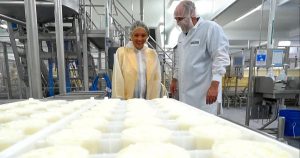
The price of dry whey weakened from $0.4875 per pound mid-September to a low of $0.41 in October before improving to $0.4425. Higher average cheese prices will be enough to improve the Class III price from $19.82 in September to around $21.80 for October.
Butter has been well above $3 per pound all of September and October reaching a record high of $3.2675 per pound. Nonfat dry milk weakened from a high of $1.58 per pound in September to a low of $1.4250 in October. Higher average butter prices will more than offset lower nonfat dry milk prices to push the Class IV price a little higher from $24.63 in September to around $24.80 for October.
Coming holidays adds to boost in butter prices
Buyers purchasing cheese and butter to build stocks to meet the upcoming strong holiday sales pushed cheese and butter prices higher. Good domestic sales as well as exports helped to strengthen prices. Compared to a year ago, August butter exports were 71% higher and cheese exports 6% higher.
But as stocks are filled we can expect lower butter and cheese prices lowering the Class III and Class IV price. Both the Class III and Class IV price could fall below $20 by December. The Class III price could end the year averaging about $21.90 compared to $17.08 for 2021. The Class IV price could average about $24.60 compared to $16.09 for 2021.
Cow numbers increase
Milk cows increased by 52,000 January to May peaking at 9.419 million. But cow numbers have declined for four consecutive months to 9.411 million in September. Milk per cow has improved with September 1.4% above a year ago. September total milk production was 1.5% higher than a year ago.
This marks three consecutive increases with July up 0.5% and August 1.7%. South Dakota continues to lead all states in increased milk production with September 14.9% above a year ago with an addition of 25,000 cows. Other states with more cows and relatively high increase in milk production were Georgia 10,000 cows and 13.1% more milk, Texas 30,000 more cows and 8.5% more milk, Iowa 12,000 more cows and 5.3% more milk, Colorado 7,000 more cows and 3.8% more milk, Arizona 4,000 more cows and 3.2% more milk, Idaho 6,000 more cows and 2.4% more milk.
California had 4,000 more cows but just 0.5% more milk. Wisconsin had 7,000 fewer cows but still 0.9% more milk. Michigan continues to lose cows down 11,000 and 0.7% less milk. New Mexico had 16,000 fewer cows and 3.5% less milk. Cow numbers were down 11,000 in Florida and 12.9% less milk. New York had 3,000 fewer cows but improved milk per cow still resulted in 2.2% more milk.
Milk price outlook
Milk prices are likely to average lower in 2023. With milk production increasing only about 0.3% in 2022 we can expect with stronger milk prices this past year higher milk production. But any increase in milk production will be hampered by high feed costs, labor shortage and labor cost, high construction cost for expansion, and fewer available dairy replacements. Also, some dairy cooperatives still have in place base plans to limited milk expansion.
So, the increase in the average number of milk cows is likely to be limited. USDA forecasts the average number of cows for the year to increase by 15,000 cows or 0.2% with a modest 0.9% increase in milk per cow resulting in just a 1.0% increase in total milk production.
Opportunities for U.S. exports
Domestic demand is likely to be dampened some with continued high inflation and at the same time the possibility of the economy being in a recession. Dairy exports are setting a record in 2022 both in volume and value. The question is can exports continue this growth path? Milk production continues below year ago levels in the EU, New Zealand and Australia, all major dairy exporters.
This leaves open opportunities for U.S. exports especially if U.S. prices of cheese, nonfat dry milk and whey products remain price competitive. But the strong U.S. dollar and many countries also facing high inflation and possible recession could dampen exports. USDA is still forecasting an increase in export volume on both a fat and skim milk basis for 2023.
Milk prices to fall in 2023, but by how much?
While the forecast is for lower milk prices in 2023, how much lower is uncertain. As of now it looks like for the first quarter Class III could be in the $19’s and Class IV in the $20’s. Second quarter prices could weaken some as milk production increases seasonally with some increase in prices third quarter and prices peaking early fourth quarter. It looks like Class IV prices may averaging higher than Class III.
USDA is forecasting fairy strong milk prices with Class III averaging $19.80 for the year and Class IV averaging $21.00. But milk prices are very sensitive to changes in milk production, domestic sales or dairy exports and can easily change higher or lower by $1 per hundredweight or more.
Because of this price risk along with anticipated high feed costs dairy producers may consider signing up for the 2023 Dairy Margin Coverage program for up to five million pounds of milk marketings at the $9.50 margin for a fee of $0.15 per hundredweight. Profits may also be protected with the Dairy Revenue Protection program and the Livestock Gross Margin Plan for Dairy. Also, dairy futures currently offer opportunities to protect favorable prices by hedging Class III or buying Class III Put options.























